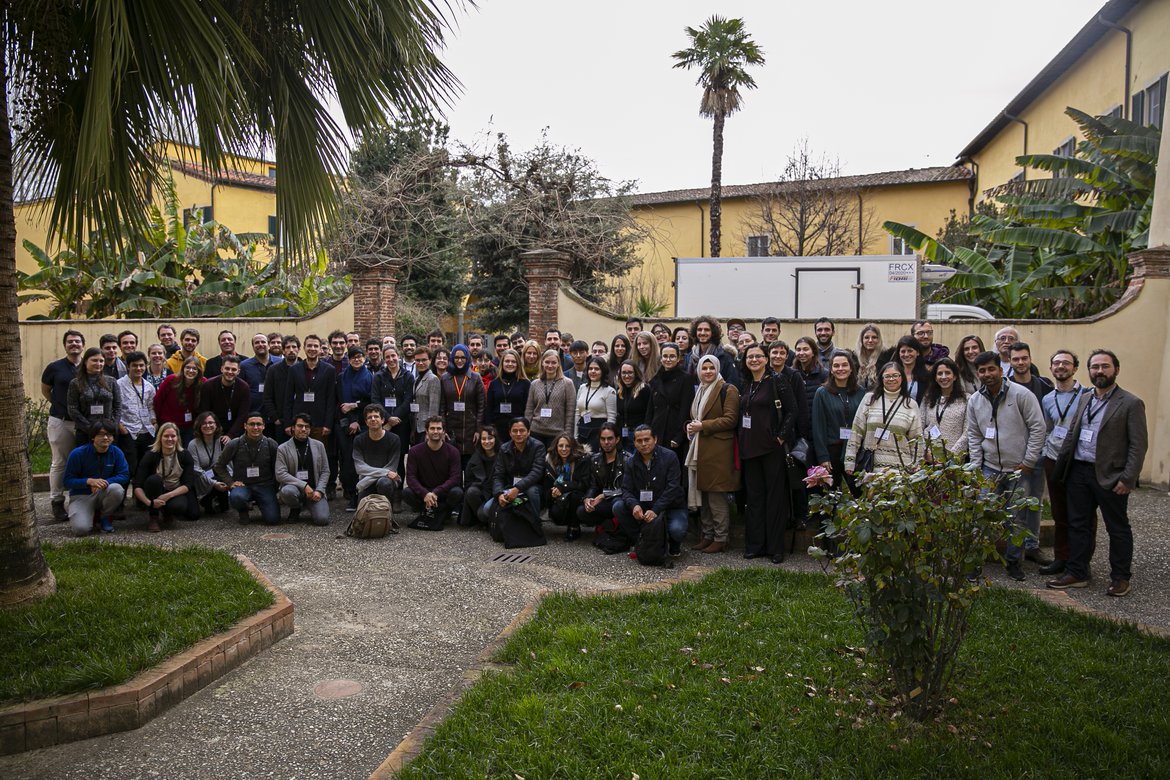5th HBP Student Conference on Interdisciplinary Brain Research
1–4 February 2021 | Virtual Conference

The human brain is such a complex system that it can only be understood by combining knowledge and practices from multiple scientific fields. The 5th HBP Student Conference provided an open forum for the exchange of new ideas amongst early career researchers across various sciences relevant to the Human Brain Project (HBP). Attendees were exposed to the data-driven brain research approach of the HBP and had the opportunity to test the EBRAINS platform thoroughly. The conference offered room for extensive scientific dialogue, both intra- and interdisciplinary, through a variety of discussion sessions, lectures and social events. It took place virtually, organised and supported by the HBP Education Programme.
Click on the button below to access the Conference Media Section to watch the recorded keynote talks and student presentations
The conference took place virtually over four days, with a versatile online schedule from 1 to 4 February 2021.
Scientific Programme
Download the digital Programme.
|
|
|
| 11:30 – 12:30 |
Petra Ritter | Charité University Medicine Berlin
|
12:30 – 12:45 |
|
|
12:45 – 14:15 |
Parallel workshops:
Build on EBRAINS I Ethics, Responsible Research & Innovation, and Dual Use What brains are we looking at? About the role of diversity in brain research Deep learning with biological neural networks in Norse
|
|
|
Break |
|
|
Student Session I: Brain dynamics and disease modelling |
|
|
Break |
|
16:30 – 17:30 |
Keynote II: Towards Biologically Realistic Models of Cortical Computation Stefan Mihalas | Allen Institute for Brain Science /University of Washington |
|
|
Break |
|
|
Networking Session I: Pub Quiz |
|
|
Timo Dickscheid | Forschungszentrum Jülich |
|
|
Break |
|
|
|
|
|
Break |
|
|
Katrin Amunts | Forschungszentrum Jülich |
|
|
Break |
|
|
Student Session II: Organistion, structure and function of neural systems
|
|
|
Break |
|
|
Poster Session I |
|
|
|
|
|
|
|
|
|
|
|
|
|
|
|
|
|
|
|
|
|
|
|
|
|
|
|
|
|
|
|
|
|
|
|
Parallel workshops:
Full steam ahead! How to successfully navigate your career journey
|
|
|
|
|
|
|
|
|
|
|
|
|
|
|
|
Confirmed Speakers
 Prof. Katrin Amunts did a postdoctoral fellowship at the C. & O. Vogt Institute of Brain Research at Duesseldorf University, Germany. In 1999, she set up a new research unit for Brain Mapping at the Research Center Juelich, Germany. In 2004, she became professor for Structural-Functional Brain Mapping, and in 2008 a full professor at the Department of Psychiatry, Psychotherapy and Psychosomatics at the RWTH Aachen University as well as director of the Institute of Neuroscience and Medicine (INM-1) at the Research Center Juelich. Since 2013, she is a full professor for Brain Research, director of the C. and O. Vogt Institute of Brain Research, Heinrich-Heine University Duesseldorf and director of the Institute of Neuroscience and Medicine (INM-1), Research Center Juelich. Katrin Amunts is the programme speaker of the programme Decoding the Human Brain of the Helmholtz Association, Germany. Since 2017 Katrin Amunts is co-speaker of the graduate school Max-Planck School of Cognition and since 2018 she is a member of the International Advisory Council Healthy Brains for Healthy Lives, Canada.
Prof. Katrin Amunts did a postdoctoral fellowship at the C. & O. Vogt Institute of Brain Research at Duesseldorf University, Germany. In 1999, she set up a new research unit for Brain Mapping at the Research Center Juelich, Germany. In 2004, she became professor for Structural-Functional Brain Mapping, and in 2008 a full professor at the Department of Psychiatry, Psychotherapy and Psychosomatics at the RWTH Aachen University as well as director of the Institute of Neuroscience and Medicine (INM-1) at the Research Center Juelich. Since 2013, she is a full professor for Brain Research, director of the C. and O. Vogt Institute of Brain Research, Heinrich-Heine University Duesseldorf and director of the Institute of Neuroscience and Medicine (INM-1), Research Center Juelich. Katrin Amunts is the programme speaker of the programme Decoding the Human Brain of the Helmholtz Association, Germany. Since 2017 Katrin Amunts is co-speaker of the graduate school Max-Planck School of Cognition and since 2018 she is a member of the International Advisory Council Healthy Brains for Healthy Lives, Canada.
Since 2016, she is the Scientific Research Director and Chair of the Science and Infrastructure Board (SIB) European Flagship, The Human Brain Project (HBP).
In order to better understand the organizational principles of the human brain, she and her team aim to integrate cyto-, receptorarchitectonic, genetic and functional as well as PLI-based maps into a multimodal atlas, which contributes to EBRAINS, the research infrastructure of the HBP. Central to her approach are the development and application of methods of high-performance computing to generate ultra-high resolution human brain models such as the BigBrain, and the Juelich-Brain, a cytoarchitectonic atlas reflecting variations in brain structure.
Session Title: Ask Me Anything!
Have you ever wondered how successful researchers built their careers? Or what it really takes to stay in academia? In this session, we invite you to an open conversation with four world-leading researchers who share what brought them to where they are now: experiences, opinions, doubts, and perhaps a few pieces of advice. In short, everything around their work. After a brief introduction from the panelists they will engage in an active dialogue with the audience. In short, this is a unique opportunity to interact with world-class researchers - and ask them anything!
 Jörg Conradt is Associate Professor at Computational Science and Technology, KTH, Stockholm. His research group explores computational principles behind how brains turn perception into behavior. The research investigates theory, models, and implementations of distributed neuronal information processing, to (a) discover key principles by which large networks of neurons operate and to (b) implement those in engineered systems to enhance their real-world and real-time performance. Before joining KTH, he was Junior Professor at TU Munich’s EEIT department. He holds an M.S. degree in Computer Science/Robotics from the University of Southern California, a Diploma in Computer Engineering from TU Berlin, and a Ph.D. in Physics/Neuroscience from ETH Zurich.
Jörg Conradt is Associate Professor at Computational Science and Technology, KTH, Stockholm. His research group explores computational principles behind how brains turn perception into behavior. The research investigates theory, models, and implementations of distributed neuronal information processing, to (a) discover key principles by which large networks of neurons operate and to (b) implement those in engineered systems to enhance their real-world and real-time performance. Before joining KTH, he was Junior Professor at TU Munich’s EEIT department. He holds an M.S. degree in Computer Science/Robotics from the University of Southern California, a Diploma in Computer Engineering from TU Berlin, and a Ph.D. in Physics/Neuroscience from ETH Zurich.
Keynote Title: Neuromorphic Algorithms and Hardware for Real-Time Real-World Robots
Spiking Neuronal Networks (SNN) offer a powerful promise to control intricate future robotic systems, such as neuro-prosthetic devices directly coupled to brain-recordings. Such SNNs need to be executed on reasonable power budgets in real-time for any real-world robotic application. The more challenging and complex sensory inputs and control algorithms become, the more troublesome is their execution. Neuromorphic hardware, such as Manchester’s / Dresden’s SpiNNaker 1+2, IBM’s TrueNorth, or Intel’s Loihi architectures, offer efficient execution of SNNs, but provide various challenges and limitations in software, interfacing, and up-scaling. This talk will present SNNs to interpret sensory input, and to provide control signals for robotic actuators. Furthermore, it will show several available neuromorphic computing platforms, and present benefits of connecting such to real-time real-world robot scenarios.

Dr. Andrew Davison is a senior research scientist in the Department of Integrative and Computational Neuroscience of the Paris-Saclay Institute of Neuroscience (CNRS/Université Paris-Saclay), France, where he leads the Neuroinformatics research group. After completing a BA in Physics at the University of Cambridge, he gained a master’s degree in Medical Physics and Clinical Engineering at the University of Sheffield and trained as a Medical Physicist before returning to Cambridge for a PhD in computational neuroscience, which was awarded in 2001. After postdoctoral fellowships at Yale University and the UNIC laboratory of the CNRS, he obtained a permanent research scientist position with the CNRS in 2006, and started his own research group within UNIC in 2010.
His research interests focus on biologically detailed modelling of neuronal networks (particularly the mammalian visual system), and on developing tools to improve the reliability, reproducibility, and efficiency of biologically realistic simulations.
Session Title: Ask Me Anything!
Have you ever wondered how successful researchers built their careers? Or what it really takes to stay in academia? In this session, we invite you to an open conversation with four world-leading researchers who share what brought them to where they are now: experiences, opinions, doubts, and perhaps a few pieces of advice. In short, everything around their work. After a brief introduction from the panelists they will engage in an active dialogue with the audience. In short, this is a unique opportunity to interact with world-class researchers - and ask them anything!
 Timo Dickscheid is heading the "Big Data Analytics" group at the Institute of Neuroscience and Medicine (INM-1), Forschungszentrum Jülich, Germany. He graduated in Computer Science at the University of Koblenz in 2006, and earned his PhD in Computer Vision and Photogrammetry at the University of Bonn in 2011 under the supervision of Prof. Wolfgang Förstner. In 2010, he joined Forschungszentrum Jülich as a post-doc in the lab of Katrin Amunts to work on medical image registration and segmentation for histological brain sections. After accepting a position as the head of Information Technology at the German Federal Institute of Hydrology in Koblenz in 2012, Timo returned to Jülich in 2014. His research group focuses on biomedical image analysis and neuroinformatics methods for building high-resolution 3D models of the human brain, and constitutes a local pillar of the national artificial intelligence research network “Helmholtz AI”. In the Human Brain Project (HBP), Timo leads the EBRAINS atlas service category (SC2), which includes the development of brain reference atlases and the corresponding software interfaces for exploration, data integration and data analysis.
Timo Dickscheid is heading the "Big Data Analytics" group at the Institute of Neuroscience and Medicine (INM-1), Forschungszentrum Jülich, Germany. He graduated in Computer Science at the University of Koblenz in 2006, and earned his PhD in Computer Vision and Photogrammetry at the University of Bonn in 2011 under the supervision of Prof. Wolfgang Förstner. In 2010, he joined Forschungszentrum Jülich as a post-doc in the lab of Katrin Amunts to work on medical image registration and segmentation for histological brain sections. After accepting a position as the head of Information Technology at the German Federal Institute of Hydrology in Koblenz in 2012, Timo returned to Jülich in 2014. His research group focuses on biomedical image analysis and neuroinformatics methods for building high-resolution 3D models of the human brain, and constitutes a local pillar of the national artificial intelligence research network “Helmholtz AI”. In the Human Brain Project (HBP), Timo leads the EBRAINS atlas service category (SC2), which includes the development of brain reference atlases and the corresponding software interfaces for exploration, data integration and data analysis.
Keynote Title: The multilevel human brain atlas in EBRAINS – Features, Use cases and Future Perspectives
The EBRAINS multilevel human brain atlas integrates maps that capture different facets of human brain organisation, in a common framework. It is defined across multiple reference spaces, zooming in from the millimeter scale in the MNI space to the micrometer level of the BigBrain. The atlas currently links cytoarchitectonic areas with ultra-high resolution BigBrain data, fiber bundles from MRI tractography, maps of functional modules, and a whole range of multimodal data features associated to various brain regions. The range and scope of available maps and features is constantly increasing. As the amount of data constituting the human atlas exceeds the disk capacity of most computers, it is designed as an online framework that you can access in a number of ways. The main entry point is our interactive 3D viewer, which allows you to explore the different facets of the atlas in 3D and to select specific data features for download. Programmatic interfaces, including a Python library, HTTP API and command line client, will become available soon.
In this lecture, I will talk about the development of key parts of this atlas: Maps and 3D models of the human brain, derived from microscopic resolution of histology using state of the art machine learning and “big data” technologies. I will walk you through the main features of the different interfaces of the EBRAINS atlas, introducing exemplary scientific use cases. Finally, I will provide an overview of the latest developments of the EBRAINS human brain atlas, which will be released in the near future.
 Prof. Steve Furber CBE FRS FREng is ICL Professor of Computer Engineering in the Department of Computer Science at the University of Manchester, UK. After completing a BA in mathematics and a PhD in aerodynamics at the University of Cambridge, UK, he spent the 1980s at Acorn Computers, where he was a principal designer of the BBC Microcomputer and the ARM 32-bit RISC microprocessor. Over 180 billion variants of the ARM processor have since been manufactured, powering much of the world's mobile and embedded computing. He moved to the ICL Chair at Manchester in 1990 where he leads research into asynchronous and low-power systems and, more recently, neural systems engineering, where the SpiNNaker project has delivered a computer incorporating a million ARM processors optimised for brain modelling applications.
Prof. Steve Furber CBE FRS FREng is ICL Professor of Computer Engineering in the Department of Computer Science at the University of Manchester, UK. After completing a BA in mathematics and a PhD in aerodynamics at the University of Cambridge, UK, he spent the 1980s at Acorn Computers, where he was a principal designer of the BBC Microcomputer and the ARM 32-bit RISC microprocessor. Over 180 billion variants of the ARM processor have since been manufactured, powering much of the world's mobile and embedded computing. He moved to the ICL Chair at Manchester in 1990 where he leads research into asynchronous and low-power systems and, more recently, neural systems engineering, where the SpiNNaker project has delivered a computer incorporating a million ARM processors optimised for brain modelling applications.
Keynote Title: Neuromorphic Computing in the HBP
Neuromorphic Computing encompasses a range of brain-inspired unconventional approaches to computation. Within the Human Brain Project, two neuromorphic systems - BrainScaleS and SpiNNaker - are available to support a range of brain-modelling and related research. The SpiNNaker (a contraction of Spiking Neural Network Architecture) platform has been developed to support real-time modelling of large-scale biological neural networks. It incorporates a million ARM processor cores with a bespoke interconnect fabric specifically designed to enable the very high connectivity of biological brains to be modelled. As neuron and synapse models are implemented in software, SpiNNaker is very flexible, and it can be used to model novel neuron models and learning rules. The SpiNNaker platform is currently being used to support a wide range of neuroscientific research, and a second generation machine is also under development.
Session Title: Ask Me Anything!
Have you ever wondered how successful researchers built their careers? Or what it really takes to stay in academia? In this session, we invite you to an open conversation with four world-leading researchers who share what brought them to where they are now: experiences, opinions, doubts, and perhaps a few pieces of advice. In short, everything around their work. After a brief introduction from the panelists they will engage in an active dialogue with the audience. In short, this is a unique opportunity to interact with world-class researchers - and ask them anything!

Stefan Mihalas joined the Allen Institute in 2011 from Johns Hopkins University, where he was a postdoctoral fellow in neuroscience and subsequently an associate research scientist. As a computational neuroscientist, Mihalas has worked on models of both molecular and systems neuroscience including nervous system development, synaptic plasticity, minimalistic spiking neuron models, self-organized criticality, visual attention and figure ground segregation. His current research interests are aimed at building models to elucidate how large networks of interacting neurons produce cognitive behaviors. At the Allen Institute, Mihalas integrates anatomical and physiological data to generate models of computation in the mouse visual system. Mihalas received his Diploma in physics and M.S. in mathematics from West University of Timisoara in Romania. He received his Ph.D. in physics from the California Institute of Technology.
Keynote Title: Towards Biologically Realistic Models of Cortical Computation
The capacity to control behavior is the fundamental characteristic of the brain. It is driven by computations implemented by biological neural networks. However, we still lack a clear understanding on what computations are implemented by parts of the nervous systems, how much of those computations is innate and how much is learned, how they are learned, and how they are put together to generate behavior.
Importantly, these computations need to be implemented by biological neural networks, which have significant differences from artificial neural networks. Salient differences include the incredible diversity in cellular and synaptic dynamics observed in the biological systems, and the large variation of the in-vivo activity resulting from the same stimuli. There is currently still a huge gap between biologically realistic models which focus on reproducing activity, and models of computations which abstract away biological realism.
I will present some small steps in bridging this gap: how it is possible for the biological system to make use of multiple long term synaptic dynamics to implement approximate evidence integration, make use of multiple short term synaptic dynamics to faster learn dynamical tasks, and make use of trial-by-trail variability to learn invariances the system needs to generalize over. However, since this is a student conference, I plan to spend a large fraction of time discussing open questions which still prevent us from constructing biologically realistic models of computation.
 Prof. Abigail Morrison is the group leader of “Computation in Neural Circuits” at INM-6/IAS-6, Forschungszentrum Jülich (Germany), the scientific lead of the “Simulation Laboratory Neuroscience” at the Jülich Supercomputing Centre and a professor of computer science at the RWTH Aachen, Germany. She holds a master’s degree in artificial intelligence and received her PhD in computational neuroscience in 2006 from the University of Freiburg, Germany.
Prof. Abigail Morrison is the group leader of “Computation in Neural Circuits” at INM-6/IAS-6, Forschungszentrum Jülich (Germany), the scientific lead of the “Simulation Laboratory Neuroscience” at the Jülich Supercomputing Centre and a professor of computer science at the RWTH Aachen, Germany. She holds a master’s degree in artificial intelligence and received her PhD in computational neuroscience in 2006 from the University of Freiburg, Germany.
Between 2006 and 2009 she was a scientific researcher at the RIKEN Brain Science Institute in Wako-Shi, Japan; she subsequently held professorships at the University of Freiburg, Germany (2009-2012, Biology) and the Ruhr University Bochum, Germany (2012-2020, Psychology). Her research interests include learning, adaptation and self-organization in spiking neural networks, dynamics and computation in neurodegenerative diseases, and high-performance simulation technology.
Session Title: Ask Me Anything!
Have you ever wondered how successful researchers built their careers? Or what it really takes to stay in academia? In this session, we invite you to an open conversation with four world-leading researchers who share what brought them to where they are now: experiences, opinions, doubts, and perhaps a few pieces of advice. In short, everything around their work. After a brief introduction from the panelists they will engage in an active dialogue with the audience. In short, this is a unique opportunity to interact with world-class researchers - and ask them anything!
 Petra Ritter heads the Brain Simulation Section at the Dept. of Neurology, Charité and Berlin Institute of Health. She is a full professor for Brain Simulation. Her research focus is on integrating neuroimaging and computational neuroscience to discover mechanisms of brain function and dysfunction. She has led local (Charité & BIH Virtual Research Environment), national (Bernstein Focus), European (VirtualBrainCloud; Co-design Project The Virtual Brain in the EU Flagship HBP SGA2) and international neuroiformatics consortia (co-lead The Virtual Brain platform with >30k software downloads), is a participant in the national research data infrastructure initiative (NFDI) NFDI4Health and a co-speaker in NFDI-Neuro and a member of the European Open Science Cloud Architecture working group. She holds an ERC Consolidator grant and is engaged in several large-scale software projects. In the €15Mill funded EU project Virtual Brain Cloud and its local partnering project Virtual Research Environment, Ritter and collaborators develop a reference architecture for cross-institutional managing and processing of radiologic imaging and associated data in compliance with GDPR. Ritter’s Brain Simulation Section is GOLD member of the International Neuroinformatics Coordination Facility (INCF).
Petra Ritter heads the Brain Simulation Section at the Dept. of Neurology, Charité and Berlin Institute of Health. She is a full professor for Brain Simulation. Her research focus is on integrating neuroimaging and computational neuroscience to discover mechanisms of brain function and dysfunction. She has led local (Charité & BIH Virtual Research Environment), national (Bernstein Focus), European (VirtualBrainCloud; Co-design Project The Virtual Brain in the EU Flagship HBP SGA2) and international neuroiformatics consortia (co-lead The Virtual Brain platform with >30k software downloads), is a participant in the national research data infrastructure initiative (NFDI) NFDI4Health and a co-speaker in NFDI-Neuro and a member of the European Open Science Cloud Architecture working group. She holds an ERC Consolidator grant and is engaged in several large-scale software projects. In the €15Mill funded EU project Virtual Brain Cloud and its local partnering project Virtual Research Environment, Ritter and collaborators develop a reference architecture for cross-institutional managing and processing of radiologic imaging and associated data in compliance with GDPR. Ritter’s Brain Simulation Section is GOLD member of the International Neuroinformatics Coordination Facility (INCF).
Petra Ritter studied medicine at the Charité University Medicine Berlin. She spent a large part of her clinical traineeships and practical year abroad: at the universities UCLA and UCSD in Los Angeles and San Diego, the Mount Sinai School of Medicine in New York and the Harvard Medical School in Boston. In 2002, she received her license to practise medicine. In 2004, she completed her doctoral thesis at the Charité and in 2010 she received habilitation in Experimental Neurology. After being Max Planck Minerva research group leader from 2011 to 2015, she assumed the lifetime position of BIH Johanna Quandt Professor for Brain Simulation at Berlin Institute of Health (BIH) and Charité Universitätsmedizin Berlin, one of Europe’s largest university hospitals. Since 2017, she is Director of the Brain Simulation Section at Charité Universitätsmedizin Berlin.
Keynote Title: Integrating neuroscience data through personalised brain simulation in protected cloud environments to infer multi-scale mechanisms of brain function and dysfunction
The challenge in studying the brain as a complex adaptive system is that complexity arises from the interactions of structure and function at different spatiotemporal scales. Modern neuroimaging can provide exquisite measures of structure and function separately but misses the fact that the brain complexity emerges from the intersection of the two. Here is where computational modelling of brain networks can help. Models that simulate different combinations of subordinate features of behaviour of a complex system that often can only be measured invasively (e.g. local population dynamics and long-range interactions) identify the combination of features that most likely give rise to emergent behaviour that often is observable noninvasively (e.g. EEG, MEG, fMRI) - and importantly those that are less likely. We can exploit the power of large-scale network models to integrate disparate neuroimaging data sources and evaluate the potential underlying biophysical network mechanisms. This approach is now feasible because of the developments in a whole-brain simulation platform, TheVirtualBrain (TVB). TVB integrates empirical neuroimaging data from different modalities to construct biologically plausible computational models of brain network dynamics. TVB is a generative model wherein biophysical parameters for the level of cell population activity and anatomical connectivity are optimized/fitted so that they generate an individual’s observed data in humans, macaques or rodents. The inferences about brain dynamics, complexity, and the relation to cognition are thus made at the level of the biophysical features (e.g., balance of excitation and inhibition in a cell population) that generated the observed data, rather than particular features of the data (e.g. FC). Through extended simulation, the TVB modeling platform allows for a complete exploration of dynamics that are consistent with a particular empirically-derived neural architecture. This exploration can span the dynamics that have been observed empirically and those that are not observed but are plausible potentials. This potentiality is directly related to complexity, in that complex systems will engender more options in the production of similar behavior, which also imparts more resilience. Potential configurations, or hidden repertoires, may also underlie broader concepts of “cognitive reserve”, which has been used to describe the ability of some persons to maintain high levels of cognitive function in aging and also in the face of damage or disease.
 Mavi Sanchez-Vives, MD PhD, is ICREA Research Professor and leader of Systems Neuroscience at the Institute of Biomedical Research August Pi i Sunyer in Barcelona, Spain. She is also co-Director of the EVENT Lab (Experimental Virtual Environments in Neurosciences and Technology) at the University of Barcelona and one of the founders of Virtual Bodyworks Inc. She is interested in the cellular and network mechanisms for the generation of spontaneous brain emergent activity in physiological and pathological conditions, neurotechnology and brain interfacing. She is also interested in brain-related applications of virtual reality, particularly in relation to body representation.
Mavi Sanchez-Vives, MD PhD, is ICREA Research Professor and leader of Systems Neuroscience at the Institute of Biomedical Research August Pi i Sunyer in Barcelona, Spain. She is also co-Director of the EVENT Lab (Experimental Virtual Environments in Neurosciences and Technology) at the University of Barcelona and one of the founders of Virtual Bodyworks Inc. She is interested in the cellular and network mechanisms for the generation of spontaneous brain emergent activity in physiological and pathological conditions, neurotechnology and brain interfacing. She is also interested in brain-related applications of virtual reality, particularly in relation to body representation.
Keynote Title: One network, many states: multiscale exploration of cerebral cortex dynamics
From deep sleep, anesthesia or coma states to wakefulness, there are profound changes in cortical emergent patterns and interactions, both in the temporal and the spatial domains. In a state of low excitability, the cortical network, both in vivo and in vitro, expresses it “default activity pattern”, slow oscillations (Sanchez-Vives et al, Neuron, 94: 993, 2017), a state of low complexity and high synchronization. Understanding the multiscale mechanisms enabling the emergence of complex brain dynamics associated to wakefulness and cognition while departing from low complexity, highly synchronized states such as sleep, is key to develop reliable monitors of brain state transitions and consciousness levels during physiological and pathological states. In this presentation, I will discuss different experimental and computational approaches aimed at unraveling how the complexity of activity patterns emerges in the cortical network as it transitions across different brain states.
PROGRAMME COMMITTEE
Chairs:
Alice Geminiani | University of Pavia
Ingrid Reiten | University of Oslo
Committee:
Petruţ Bogdan | The University of Manchester
Sandra Díaz | Forschungszentrum Jülich
Jens Egholm Pedersen | Royal Institute of Technology
Carmen Lupascu | Italian National Research Council
Alper Yegenoglu | Forschungszentrum Jülich
ORGANISER
HBP Education Programme | Medical University Innsbruck
CONTACT
education@humanbrainproject.eu
FAQs & all you need to know
Registration is mandatory and is open until 14 January 2021.
Attendance is open to anyone and free of charge.
A: I already have an EBRAINS account.
- Click on the “Register” Button
- Log in to your EBRAINS account
- Enter your availabilities and accept the GDPR Statement.
- Click on “Please provide additional info by filling out this form (person and meeting related questions)” and enter the requested details.
- Once you have completed all fields and clicked on “Update”, you will receive a registration confirmation via e-mail. (Please note that you will receive a confirmation e-mail only for the first time you have entered all details. In case you update your registration details, no additional e-mail will be sent).
B: I do not yet have an EBRAINS account.
- Please go to https://ebrains.eu/register and create your account free of charge. As the EBRAINS Access Policy requires that users identify themselves by means of an institutional email address, please make sure to register with your institutional e-mail address.
- All new users with a personal institutional e-mail address from a pre-identified institution will be provided an expedited registration process.
- If your institution is not yet on the list of pre-identified institutions, please contact the EBRAINS support team from your institutional e-mail address and it will be added promptly.
- If you cannot register with an institutional e-mail address or experience any other problems, please contact us at education@humanbrainproject.eu.
- All new users with a personal institutional e-mail address from a pre-identified institution will be provided an expedited registration process.
- Once you have received your EBRAINS account please follow the steps from option A.
The link to our virtual conference platform as well as the online credentials will be sent out to all registered participants a few days prior to the conference. If you haven’t received your credentials until 27 January 2021 please reach out to education@humanbrainproject.eu or if you experience any other issues.
The conference starts on Monday 1 February and lasts until Thursday 4 February 2021. It will be a virtual conference and the programme will comprise keynote lectures, student sessions, poster sessions as well as social events.
A more detailed schedule will be published here on this webpage during autumn 2020.
Please note that the abstract submission is already closed. If you have submitted your abstract and are now preparing the final version, please make sure to align with the guidelines below.
Authorship
Please accurately include all co-authors and their affiliations. If in doubt whether a person’s contributions should or should not be considered as authorship, please refer to
http://www.icmje.org/icmje-recommendations.pdf.
Abstracts
Abstracts must be in a Word document format. The abstract word and character limits are as follows:
- Title: 500 characters
- Text: 1,000 words
- Number of Figures: 2
- No Supplementary Material
Abstracts that should be included in the proceedings, must be organised according to the IMRaD format [Introduction/Motivation, Methods, Results and Discussion], with several sentences addressing each of these elements. Please find a template for your convenience.
References should be included at the end of the abstract. Please note that the word count includes captions but not references. It is allowed to add acknowledgements to the abstract.
To make this virtual conference an interactive experience, it is important that you have access to a stable internet connection, good audio (with microphone) and ideally (not mandatory) a webcam for video communication.
Also, to have the full conference experience it is important that you have installed the Zoom Desktop Client application (v5.3.0 or higher) and that you access the conference platform via the latest version of Google Chrome.
Submitters whose abstract have been accepted for a poster presentation can find the virtual poster guidelines here.
Posters must be submitted in PDF format via email to the HBP Education Programme until latest 20 January 2021.
Please name your poster: # of submitted abstract_family name of presenting author.pdf, e.g.: 1_Miller.pdf
If you have any questions about the abstract submission or the conference, please contact us at education@humanbrainproject.eu.
All times in the programme schedule are UTC+1 = CET.
To prevent missed sessions, we recommend to use a time zone converter in advance.



